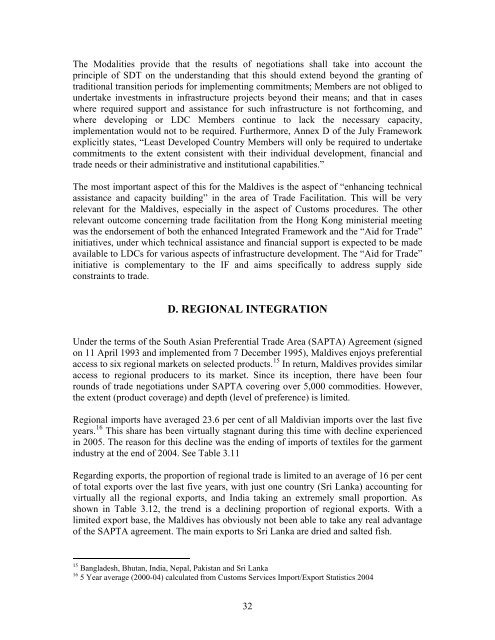DTIS, Volume I - Enhanced Integrated Framework (EIF)
DTIS, Volume I - Enhanced Integrated Framework (EIF)
DTIS, Volume I - Enhanced Integrated Framework (EIF)
You also want an ePaper? Increase the reach of your titles
YUMPU automatically turns print PDFs into web optimized ePapers that Google loves.
The Modalities provide that the results of negotiations shall take into account the<br />
principle of SDT on the understanding that this should extend beyond the granting of<br />
traditional transition periods for implementing commitments; Members are not obliged to<br />
undertake investments in infrastructure projects beyond their means; and that in cases<br />
where required support and assistance for such infrastructure is not forthcoming, and<br />
where developing or LDC Members continue to lack the necessary capacity,<br />
implementation would not to be required. Furthermore, Annex D of the July <strong>Framework</strong><br />
explicitly states, “Least Developed Country Members will only be required to undertake<br />
commitments to the extent consistent with their individual development, financial and<br />
trade needs or their administrative and institutional capabilities.”<br />
The most important aspect of this for the Maldives is the aspect of “enhancing technical<br />
assistance and capacity building” in the area of Trade Facilitation. This will be very<br />
relevant for the Maldives, especially in the aspect of Customs procedures. The other<br />
relevant outcome concerning trade facilitation from the Hong Kong ministerial meeting<br />
was the endorsement of both the enhanced <strong>Integrated</strong> <strong>Framework</strong> and the “Aid for Trade”<br />
initiatives, under which technical assistance and financial support is expected to be made<br />
available to LDCs for various aspects of infrastructure development. The “Aid for Trade”<br />
initiative is complementary to the IF and aims specifically to address supply side<br />
constraints to trade.<br />
D. REGIONAL INTEGRATION<br />
Under the terms of the South Asian Preferential Trade Area (SAPTA) Agreement (signed<br />
on 11 April 1993 and implemented from 7 December 1995), Maldives enjoys preferential<br />
access to six regional markets on selected products. 15 In return, Maldives provides similar<br />
access to regional producers to its market. Since its inception, there have been four<br />
rounds of trade negotiations under SAPTA covering over 5,000 commodities. However,<br />
the extent (product coverage) and depth (level of preference) is limited.<br />
Regional imports have averaged 23.6 per cent of all Maldivian imports over the last five<br />
years. 16 This share has been virtually stagnant during this time with decline experienced<br />
in 2005. The reason for this decline was the ending of imports of textiles for the garment<br />
industry at the end of 2004. See Table 3.11<br />
Regarding exports, the proportion of regional trade is limited to an average of 16 per cent<br />
of total exports over the last five years, with just one country (Sri Lanka) accounting for<br />
virtually all the regional exports, and India taking an extremely small proportion. As<br />
shown in Table 3.12, the trend is a declining proportion of regional exports. With a<br />
limited export base, the Maldives has obviously not been able to take any real advantage<br />
of the SAPTA agreement. The main exports to Sri Lanka are dried and salted fish.<br />
15 Bangladesh, Bhutan, India, Nepal, Pakistan and Sri Lanka<br />
16 5 Year average (2000-04) calculated from Customs Services Import/Export Statistics 2004<br />
32
















